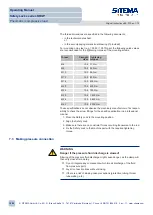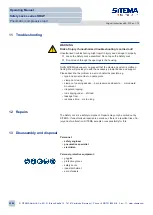
Follow this procedure:
1. Apply the operating pressure to pressure port L.
2. Run the drive opposite to the load direction. The drive's power must cor-
respond to the weight of the load.
3. Maintain the operating pressure to keep the clamp permanently open.
ð
Proximity switch 2 signals “clamping released”.
If the
clamp is not released
, it is often the case that the necessary
counter-movement of the rod
has not taken place, or the counter-move-
ment is insufficient.
To
release
the clamp
after securing the load
(see
24]), it is sufficient to apply the operating pressure to pressure port L,
provided the load had not previously dropped.
To
release
the clamp
after taking up the load
24]) applying the operating pressure to L is not sufficient. The rod
must additionally be moved opposite to the load direction.
9.2 Securing the load
Follow this procedure:
1. Stop the rod completely.
2. Disconnect the pressure from pressure port L.
ð
The clamp closes.
ð
The load has been secured.
ð
Proximity switch 1 signals “load secured”.
9.3 Taking up the load
Pressure port L is depressurized. The holding force is built up only when the
load continues moving in the direction in which it is to be secured.
► Apply the load to the Safety Lock (such as by releasing the service
brake).
ð
The Safety Lock takes up the load.
10 Inspection, maintenance and cleaning
10.1 Inspection
Always inspect the Safety Lock when carrying out machine servicing. When
doing so, check that the following components are in good working condition:
Component
Good condition
Wiper
(rod openings)
The sealing lip shows no signs of wear.
(Damaged wipers might let dirt into the clamping system.
Worn or damaged wipers must be replaced by original
SITEMA parts.)
Operating Manual
Safety Locks series KRGP
Pneumatic / compressive load
Original instructions BA-S12-en-1-15
© SITEMA GmbH & Co. KG . G.-Braun-Straße 13 . 76187 Karlsruhe (Germany) . Phone: +49(0)721/98661-0 . Fax: -11 . www.sitema.com
24/28





































